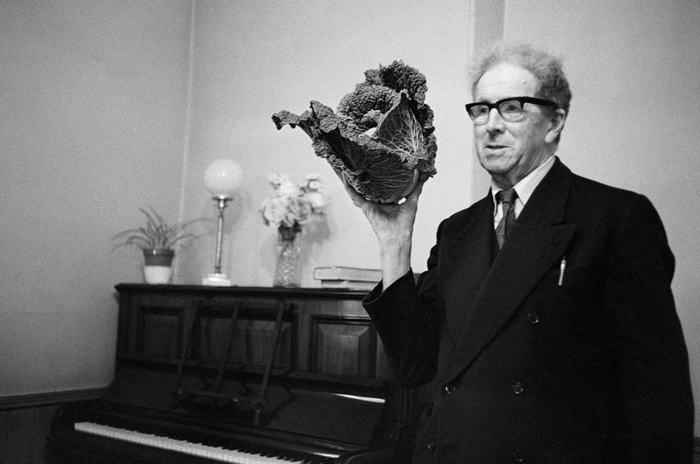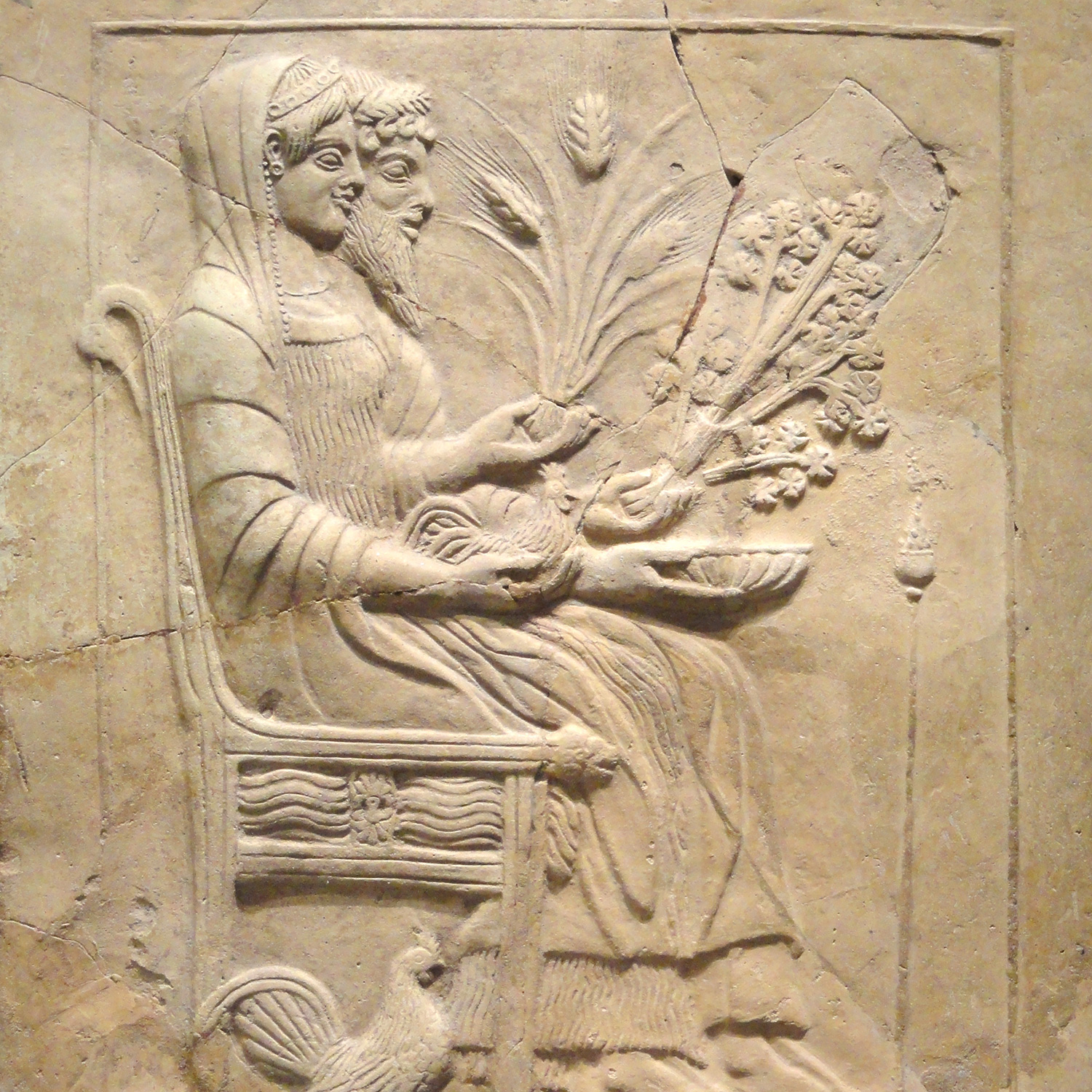Lettuce now: tend to our garden

Brassicae laudes longum est exsequi.
The glories of the cabbage would be long in the telling.
On reading Sir Francis Bryan’s translation of Antonio de Guevara’s A Looking Glasse for the Court, one encounters the following passage:
Nowe when the Ambaſſadours arived at his houſe, they found him in a litle garden wher he was ſettyng of Lettys and Onyons: And hearyng what they ſayd unto him, he anſwered in this wiſe: Do you not thynke, my frendes, that it is much better for him that can ſowe his Lettys, and aftwarde pleaſantely and merely eate the ſame, ſo ſtill to exerciſe himſelfe, then to returne and entre into the goulfe of troubles in a common welth? I haue aſſayed both, I know what it is to commaund in the court, and what it is to liue & labor in the village, where fore I pray you ſuffer me here to abide in pacience, for I deſire rather here to liue with the labor of my handes, then in the ſorow and cares of an Empyre. (ch. 17)
My first thought on reading was: this can’t possibly be right. Lettuce? While I have no doubt that Guevara did mention lettuce, 1 it seemed unlikely to me that Diocletian would be associated with lettuce in the original source: cabbages would be a more probable choice. Guevara ascribes this anecdote to Aelius Spartianus, who may or may not have existed and may or may not have been among the authors of the Historia Augusta, but who in any case said no such thing, as his (possible) section of the work was addressed to Diocletian, not about him. 2 The closest thing I could find to this anecdote was the following passage from the Epitome de Caesaribus (39.6) by Sextus Aurelius Victor (fourth century CE):
Diocletianus vero apud Nicomediam sponte imperiales fasces relinquens in propriis agris consenuit. Qui dum ab Herculio atque Galerio ad recipiendum imperium rogaretur, tamquam pestem aliquam detestans in hunc modum respondit: ‘Utinam Salonae possetis visere olera nostris manibus instituta, profecto numquam istud temptandum iudicaretis.’
Indeed, Diocletian relinquished the imperial fasces of his own accord at Nicomedia and grew old on his private estates. It was he who, when called upon by Herculius and Galerius to resume control, responded – as though avoiding some kind of plague – thus: ‘If you could see at Salona the olera [cabbages? vegetables?] raised by our hands, you would surely never judge that a temptation.’ 3
This is the passage cited by Gibbon for his account of Diocletian’s refusal to return to power: ‘He rejected the temptation with a smile of pity, calmly observing, that if he could show Maximian the cabbages which he had planted with his own hands at Salona, he should no longer be urged to relinquish the enjoyment of happiness for the pursuit of power.’ Say what you like about olera, though – they are not (just) cabbages. Rather, although holus (–eris; also olus) could perhaps mean ‘cabbage’, 4 it can also indicate greens and kitchen plants more generally, 5 forming the root (ha!) for holerarium, kitchen garden. 6 Thus in the De medicina of Celsus (first century CE), one finds:
Ex holeribus valentior rapa napique et omnes bulbi, in quibus cepam quoque et alium numero, quam pastinaca vel quae specialiter radicula appellatur. Item firmior brassica et beta et porrum quam lactuca vel cucurbita vel asparagus
Of vegetables (ex holeribus) the turnip and navew [i.e. a type of small turnip] and all bulbs, among which I include the onion also and garlic, are stronger than the parsnip, or that which is specially called a root. Also cabbage (brassica) and beet and leek are stronger than lettuce (lactuca) or gourd or asparagus (2.18.5). 7
This general sense of holera as vegetables (which here includes bulbs such as onion and garlic in addition to crucifers, gourds, lettuce, &c.) can also be found in Vitruvius (first century BCE), who notes that if grains give out during a siege, the defenders can be sustained by holeribus, carne seu leguminibus (vegetables, meat, or legumes; 5.9.8).

Pinax with Persephone and Hades (holding some celery, or maybe parsley), 500–450 BCE, Cleveland Museum of Art
Latin is not at a loss for words that can be done into English as ‘cabbage’. One of Martial’s two-line epigrams makes use of three: Fascis coliculi: Ne tibi pallentes moveant fastidia caules, / Nitrata viridis brassica fiat aqua (Bunch of stalks: Lest the pale stems stir up your queasiness / make the cabbage green with nitron water; 13.17). 8 Of these three, the most cabbagy, in my opinion, is brassica, which is mentioned in the quotation from Celsus above and familiar from seed packets for common heads of cabbage – Brassica oleracea var. capitata – everywhere, although caulis/colis provides the seed for the English ‘cole’ (as in slaw). 9
In Plautus’s (second century BCE) Pseudolus one finds a word-mad cook complaining (before being carried away on a flood of made-up ingredients) of other (inferior) chefs, who mix other plants into the shoddy greens (herba) that form the bulk of their dishes: indunt coriandrum, feniculum, alium, atrum holus, / apponunt rumicem, brassicam, betam, blitum (they put in coriander, fennel, garlic, black lovage [atrum holus]; they add, too, sorrel, cabbage [brassica], beet, and spinach; 814f.). 10 Note that one variety of holus (the dark kind) is here distinguished from brassica as (potentially) another variety. A fourth or fifth century (CE) poem of uncertain authorship and dubious literary merit also includes cabbages within an inventory of ingredients for a potentially medicinal (but undoubtedly unpleasant) mixture that includes: 11
Floribus et variis herbis, holere atque metallis
[health-giving substances such as …] flowers and various herbs, vegetable and metals (29)Quod viride hortus habet vel quod carnaria siccum,
Alia serpullumque herbas thymramque salubrem
Brassicaque et rafanos ac longis intiba fibris
Et mentam et sanpi coriandrum protototumumque
Erucam atque apium, malvuam betamque salubrem
Rutam et nasturcum et amara absinthia misce
Puleiumque potens necnon et lene cyminum. (34–40)…mix what the garden has fresh or the smokehouse dry,
garlic and thyme, herbs and wholesome savory,
cabbage and collards and long-fibered endive,
mint and mustard and first-cut coriander,
rocket as well as parsley, mallow and wholesome beet,
rue and cress and bitter wormwood,
powerful pennyroyal and soothing cumin.
Interestingly, this inventory includes the word rafanos, which Cilliers translates (not incorrectly) as radishes, but which I have put into English as collards in a nod to its origins in the Greek ῥάφανος (Attic for ‘cabbage’, cf. κράμβη). Note, too, that the holus in line 29 is used in a general sense, while brassica is used in line 36 to identify something (cabbage? broccoli? kale?) more specific. In any case, Pliny the Elder (first century CE) in turn identifies several varieties of brassica, starting from Greek authorities:
in tres species divisere eam graeci antiquissimi: crispam, quam selinada vocaverunt a similitudine apii foliorum, stomacho utilem, alvum modice mollientem; alteram heliam, latis foliis e caule exeuntibus, unde caulodem quidam vocavere, nullius in medicina momenti. tertia est proprie appellata crambe, 12 tenuioribus foliis et simplicibus densissimisque, amarior, sed efficacissima.
The ancient Greek writers distinguished three varieties of cabbage: the curly cabbage, to which they have given the name of ‘selinada’ 13 from the resemblance of its leaf to that of parsley, beneficial to the stomach, and moderately relaxing to the bowels; another is ‘helia’, with broad leaves running out from the stalk – a circumstance, owing to which some persons have given it the name of ‘caulodes’ – of no use whatever in a medicinal point of view; and a third, the name of which is properly ‘crambe’, with thinner leaves, of simple form, and closely packed, more bitter than the others, but extremely efficacious in medicine (33.9.2). 14
He ends with two other varieties, cyma (20.35) and lapsana (20.37), which are difficult to distinguish and may not be cabbagy (in the modern sense) at all. According to Pliny, Cato the Elder (second century BCE) thought the curly cabbage (possibly celery) the best, followed by the ‘caulodes’, which sounds rather more like a bunch of cabbage (or maybe kale). Indeed, Cato’s De agricultra contains a lengthy discussion of different types of brassicae, 15 with particular attention to their medicinal qualities, although there is a whiff (faint but certain) of virtuous posturing, as cabbage is a subject for philosophers, the perfect sign of simple living, as suggested in an inscription of a fragment by the Epicurean Diogenes of Oinoanda (see p. 43 in particular; paywall). I shall not, however, trouble you with Cato’s remarks at length, save to note that they do not add to the cruciferous vocabulary – although he provides some recipes that do not sound terrible (though perhaps bathing children in the urine of someone who eats a steady diet of cabbage might not now be considered a best practice). 16 I will, however, allow Cato the last word:
Brassica est quae omnibus holeribus antistat
The cabbage surpasses all vegetables (156)
- Which did indeed turn out to be the case, as Diocletian is described as escardando unas lechugas y podando unas parras [weeding lettuce and trimming vines].[↩]
- I am stating positively what is in fact supposition; this feels appropriate to the source.[↩]
- Translation follows that of Banchich (2018), with some modifications.[↩]
- Ovid’s Philemon and Baucis dine on shredded holus foliis fried up with bacon (8.648), which seems to be nearly universally translated as ‘cabbage’, but could as easily be thought of as collard greens (a distinction perhaps without a difference). On the many varieties of crucifers, see Mabry et al. ‘The Evolutionary History of Wild, Domesticated, and Feral Brassica oleracea (Brassicaceae)’. Molecular Biology and Evolution 38, no. 10 (October 2021): 4419–4434 (open access). Also, if one wants to know more about food consumption and/or gastronomy in the ancient world, the works of Andrew Dalby (and they are numerous) would perhaps be a good starting point. For an earlier attempt to sort out what these different cruciferous plants actually are, see Parkinson’s Theatrum botanicum, chapter 53 (1640).[↩]
- Although cf. λάχανον (garden herbs) → modern Greek λάχανο: cabbage; this shows up at Romans 14:2: ὃς μὲν πιστεύει φαγεῖν πάντα, ὁ δὲ ἀσθενῶν λάχανα ἐσθίει / alius enim credit manducare omnia qui autem infirmus est holus manducat / ‘For one believeth that he may eat all things: another, who is weak, eateth herbs’.[↩]
- This is not uncommon; indeed, it is rather like saying ‘carriage’ to indicate any number of vehicles from a barouche to a troika. Certainly a chaise is a carriage, but it is not necessarily a hansom.[↩]
- Translation follows Spencer (1971).[↩]
- It is worth noting that Columella provides a remedy for bovine indigestion that involves about thirty cabbage stems bundled and cooked in two gallons of hot water, then dipped in vinegar (Remedio erunt aquae calidae duo congii, et mox triginta brassicae modicae caules coeti et ex aceto dati (6.6.1).[↩]
- You might think, incidentally, that the Latin name for the cabbage, in which brassica is the genus and holus (essentially) is the species, would be a strong argument in favor of the interpretation of the latter as ‘cabbage’ – but based on the other texts available, that does not seem to match classical usage. This is, however, about cabbages, so it can’t be taken too seriously – and far be it from me to quibble with Linnaeus. As Horace put it in one of his Satires: Nec vincet ratio, tantumdem ut peccet, idemque / Qui teneros caules alieni fregerit horti, / Et qui nocturnus divum sacra legerit (nor will reason carry the point that he who snaps the tender cabbage-stalks in his neighbor’s garden sins so much and in the same way as he who at night steals things consecrated to the gods; 1.3.115–7).[↩]
- Translation follows Riley (1912), with minor exceptions; for more on the magic of this scene, see Lowe’s article ‘The Cook Scene of Plautus’ Pseudolus’. Classical Quarterly 35, no. 2 (1985): 411–416 (paywall).[↩]
- Translation based, with some modifications, on that of Cilliers, ‘The De medicina, a 4th/5th-Century Poem of Gallo-Roman Origin, Rediscovered’. Mnemosyne 71, no. 1 (2018): 125–144 (paywall); see esp. p. 133, 135, 140; a full text of the Latin poem can be found on pp. 131–134.[↩]
- Possibly Brassica cretica, a type of wild cabbage.[↩]
- Cf. σέλινον/σελινοειδής, celery, which can look rather like parsley; although on the potential dangers of this translation, see Broneer’s article on ‘The Isthmian Victory Crown’. American Journal of Archaeology 66, no. 3 (July 1962): 259–263 (paywall).[↩]
- Translation follows that of Bostock and Riley (1855), with some modifications.[↩]
- Including the ‘Pythagorean’ brassica, quid in ea boni sit salubritatisque; for all, see sections 156–157.[↩]
- For a more comprehensive account of ancient cabbagy testimonia, which I found, to my irritation, after completing a draft of this post, see the article by Maggioni et al. ‘Domestication, Diversity and Use of Brassica oleracea L., Based on Ancient Greek and Latin Texts’. Genetic Resources and Crop Evolution 65 (2018): 137–159 (open access).[↩]
